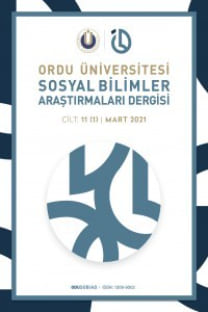Foreign Language Teaching in Secondary Schools in Germany and Turkey: A Comparative Study
Yabancı dil öğretiminin küreselleşen dünyayla birlikte giderek daha önemli bir unsur haline geldiği bilinmektedir. Bazı ülkeler yabancı dil öğretiminde daha ileri bir seviyeye ulaşmışken, bazıları istediği başarı seviyesine ulaşamamaktadır. Ülkelerin yabancı dil öğretim kalitesini anlamak, eğitim sistemlerini nasıl şekillendirdiklerini bilmekle mümkündür. Bu çalışmada Almanya’nın ve Türkiye’nin ortaokul yabancı dil eğitim sistemleri karşılaştırmalı olarak incelenmiştir. Bunu yaparken eğitim politikası, öğretilen yabancı diller, müfredat, haftalık yabancı dil ders saatleri, öğretim metotları ve öğretim materyalleri ele alınmıştır. Amaç eğitim sistemlerini karşılaştırarak farklılıkları ve benzerlikleri ortaya çıkarmak ve bu okulları yabancı dil eğitiminde hangi faktörlerin başarılı kıldığını belirleyebilmektir. Çalışmada nitel bir araştırma yöntemi olan doküman analizi yöntemi kullanılmıştır. Verilerin toplanmasında literatür taraması, dokümantasyon ve metin incelemesi yapılmıştır. Çalışmada elde edilen bulgulara göre, iki ülkenin ortaokul yabancı dil eğitim sistemindeki benzer noktalara bakıldığında, hem Almanya’nın hem Türkiye’nin Diller için Ortak Avrupa Referans Çerçevesini benimsediği, birinci yabancı dil olarak İngilizcenin müfredatta önemli bir yer tuttuğu ve derslerin hayata dair güncel konulardan oluştuğu tespit edilmiştir. Farklılıklara gelindiğinde Almanya'da müfredatın eyaletten eyalete değiştiği, yabancı dil ders saatlerine Türkiye'den daha fazla zaman ayrıldığı ve öğretim materyallerinin Türkiye’ye göre daha zengin olduğu belirlenmiştir. Ayrıca her iki ülkenin iletişimsel yaklaşıma ve iletişimsel becerilere önem vermesiyle birlikte, Türkiye’deki okullarda dilbilgisi çeviri yönteminin hala uygulandığı, Almanya’nın ise eylem odaklı yaklaşımı ve iletişimsel becerileri benimseyerek yabancı dil öğretiminde daha fazla ilerleme kaydettiği saptanmıştır.
Anahtar Kelimeler:
Yabancı Dil Öğretimi, Ortaokul, Almanya, Türkiye, Eğitim Sistemi
Foreign Language Teaching in Secondary Schools in Germany and Turkey: A Comparative Study
It is known that foreign language teaching has become an increasingly important element with the globalizing world. While some countries have reached a higher level in foreign language teaching, some cannot reach the level of success they want. Understanding the foreign language teaching quality of countries is possible by knowing how they shape their education systems. In this study, the secondary school foreign language education systems of Germany and Turkey were examined comparatively. In doing so, education policy, foreign languages taught, curriculum, weekly foreign language course hours, teaching methods and teaching materials were discussed. In this study, the secondary school foreign language education systems of Germany and Turkey were examined comparatively. While doing this, education policy, foreign languages taught, curriculum, weekly foreign language course hours, teaching methods and teaching materials were discussed. The aim is to reveal differences and similarities by comparing education systems and to determine which factors make these schools successful in foreign language education. The aim is to reveal differences and similarities by comparing education systems and to determine which factors make these schools successful in foreign language education. Document analysis method, one of the qualitative research methods, was used in the study. Literature review, documentation and text analysis were used to collect data. According to the findings of the study, both Germany and Turkey have adopted the Common European Framework of Reference for Languages, English as the first foreign language has an important place in the curriculum and the lessons consist of current issues about life. When it comes to differences, it was determined that the curriculum in Germany changed from state to state, more time was allocated to foreign language course hours than in Turkey, and it is richer than the curriculum in Turkey in terms of teaching materials. In addition, with both countries emphasis on communicative approach and communicative skills, it has been determined that the grammar translation method is still applied in schools in Turkey, while Germany has made more progress in foreign language teaching by adopting an action-oriented approach and communicative skills.
Keywords:
Foreign Language Teaching, Secondary School, Germany, Turkey, Education System,
___
- Akbaşlı, S., & Üredi, L. (2014). Eğitim sistemindeki 4+4+4 yapılanmasına ilişkin öğretmen görüşleri. Journal of Teacher Education and Educators, 3(1), 109-136.
- Aslan, Y. (2016). Comparison of primary school foreign language curricula of Turkey, Germany and the Netherlands. Journal of Education and Training Studies, 4(8), 34-43. https://doi.org/10.11114/jets.v4i8.1581
- Aydoğmuş, M., & Kurnaz, A. (2017). Validity and reliability of middle school English course attitude scale. Journal of Research in Education, Science and Technology, 2(2), 14-24.
- Bliesener, U., Tapia, I., & Blochmann, G. M. (1998). Foreign language teaching in Germany. Bildung und Wissenschaft, 2-32. https://files.eric.ed.gov/fulltext/ED436098.pdf
- Bowen, G. A. (2009) Document analysis as a qualitative research method. Qualitative Research Journal, 9, 27-40. http://dx.doi.org/10.3316/QRJ0902027
- Ceylan, C., Gümüş, G., & Kabukçu, G. (2019). Happy English 5 ders kitabı. Başaran Yayıncılık. https://ders.eba.gov.tr/
- Chandra, S. S., & Sharma, R. K. (2004). Research in education. Atlantic Publishers & Distributors.
- Council of Europe. (2018, February). Common European framework of reference for languages: Learning, teaching assessment. Companion Volume with New Descriptors. Strasbourg: Council of Europe. https://rm.coe.int/cefr-companion-volume-with-new-descriptors-2018/1680787989
- Council of Europe. (2020, April). Common European framework of reference for languages: Learning, teaching assessment. Companion Volume with New Descriptors. Strasbourg: Council of Europe. https://rm.coe.int/common-european-framework-of-reference-for-languages learning-teaching/16809ea0d4
- ISSN: 1309-9302
- Yayın Aralığı: Yılda 3 Sayı
- Başlangıç: 2010
- Yayıncı: -
Sayıdaki Diğer Makaleler
Foreign Language Teaching in Secondary Schools in Germany and Turkey: A Comparative Study
Ateizmden Teizme: Bir Vaka İncelemesi
Ramazan Eğlencelerinde Ezgili Mânilerin Korunması ve Yaşatılmasının Önemi: Kütahya Küpecik Örneği
Göçer Kültürün Oluşumunda Çevresel ve Kültürel Dinamikler
Klâsik Türk Şiirinde Kâşâne Mefhumu
Ortaokul Öğrencilerinin Problem Çözme Becerileri ile Eleştirel Düşünme Becerileri Arasındaki İlişki
Gürbüz OCAK, Elif BAHÇEĞİL YAZICIOĞLU, Akın KARAKUYU
Askeri Ceza Yargılaması ve 7329 Sayılı Kanunla Yapılan Değişikliklerin Değerlendirilmesi
Türkiye’de Yerel Yönetim Reformları: Belediye Yönetimi
Sungurlu’nun Yörüklü Köyündeki Ergülü Baba (Sahra) Camisi (Zâviyesi) ve Bütüncül Koruma Önerileri
